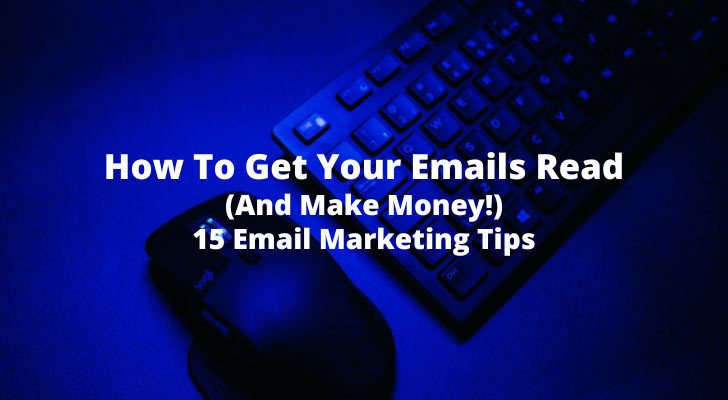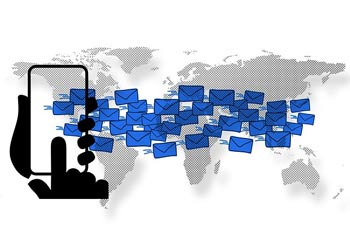It's ridiculous we are bombarded with emails. You are annoyed by the number of emails you receive, and you are sending out the same kind of emails to others, and that's even more ridiculous. Really hard to make yours stand out, isn't it? How can you get your emails to read when there are so many others vying for attention?
If you have some basic marketing skills, you can at least make sure that your messages are getting through to your target audience. I will share some email marketing tips to help you get your message read today. From the subject line to the call to action, I will cover all the basics you need to know to make your email marketing campaigns successful.

1. The Subject Line
The subject line is the first thing people see when they open their inboxes, so it’s crucial that you make a good impression. Keep your subject lines short - under 50 characters is ideal. Be clear about what’s inside – no one likes to be tricked into opening an email. And make sure your subject line is relevant to the rest of your email content; otherwise, you run the risk of appearing spammy.
2. The Preview Text
The preview text is the first 40-100-or so characters of your email body that appear in the inbox, depending on the subscriber's mail service provider and their settings.
It's what encourages subscribers to open your email, so it's important to make a good impression. Here are some tips for writing effective preview text:
- Keep it short and straightforward.
- Write in sentence case. This means using proper grammar and punctuation and avoiding all caps or all lowercase letters.
- Use actionable language. Avoid using marketing jargon or buzzwords. Be a lot more direct by using words that you normally use with friends. Use "college adjective" words less frequently, such as 'effectively', 'compelling', 'operational', etc.
3. The "From" Field
How you name yourself (to who you are sending your email) should not be underestimated. It's also the first thing people see when they open your email, and it sets the tone for the rest of the message. Here are a few tips to make sure your From field is working for you:
Use a consistent "from" name
If you're using a different "from" name or address for every email you send, people are going to have a hard time recognizing your emails in their inboxes. Pick one that you'll use for all of your email marketing, and stick with it.
Make sure your "from" name is recognizable
Your "from" name should be something that people will recognize as coming from you or your business. Avoid using generic names or addresses that could apply to anyone, such as;
- 'Info' 'Admin' or 'Support'
- Just a first name, e.g. 'Steve', 'Rachael'.
Use a friendly "from" name
People are more likely to open an email if it looks like it's from a friend, so try to use a "from" name that sounds friendly and personal. Avoid using formal titles or impersonal addresses such as;
- Mr C. Brown
- jessie.3356k@gmail.com
4. The Email Copy

Writing compelling copy that engages the reader and entices them to keep reading is always the hardest challenge. Here are some tips for writing email copy that will get your messages read:
- Keep it brief and to the point: Avoid unnecessary information and stay on point.
- Use engaging language: Use active and positive language in your emails to make them more enjoyable to read. Avoid using jargon or technical terms that might turn readers off.
- Use formatting wisely: Use formatting such as headings, bullet points and white space to break up your text and make it easier to scan. Too much text can be overwhelming, so use formatting techniques to make your emails more readable.
- Call to action: Make sure each email has a clear call to action, whether it’s clicking through to a website or taking a specific action. Without a call to action, readers may not know what you want them to do next.
5. The Call-To-Action
Your call-to-action (CTA) is the most important part of your email marketing campaign. It's what tells your subscribers what you want them to do next. Without a strong CTA, your email campaigns will fall flat and your subscribers will quickly lose interest. Here are some tips for creating an effective CTA:
- Again, keep it short: Your CTA should be clear and concise. It should be easy for your subscribers to understand what you want them to do.
- Make it actionable: Use active verbs that encourage your subscribers to take action. For example, "Sign up now," "Download our free report," or "Join our mailing list."
- Use persuasive language: Use language that compels your subscribers to take action. For example, "Don't miss out on this great opportunity!" or "act now and get 50% off!"
- Use a strong offer: Give your subscribers a reason to take action by offering them something they can't resist, such as a discount, free shipping, or exclusive access to content.
- Create a sense of urgency: Use words like "now," "today," or "limited time only" to create a sense of urgency and encourage your subscribers to take action immediately.
6. Timing is Everything
Email is one of the most commonly used forms of communication, but it can also be one of the most challenging. In order to get your emails read, you need to consider the timing of your email campaigns.
The Best Time Of Day
It's hard to determine the "best time" if your subscribers are from all over the world. Your email marketing service may be able to send your emails at the recipient's local time. So check it first.
The best time to send an email is often dependent on your audience. If you're targeting consumers, the best time to send an email is during the work week, or during business hours. However, if you're targeting other businesses, you may want to send your emails over weekends or evenings when people are more likely to have free time.
7. Frequency
It's also important to consider the frequency of your email campaigns. If you're sending too many emails too often, people will start to ignore them or even flag your emails as spam. On the other hand, if you're not sending enough emails, people will forget about you. If they can't remember signing up with you, they may flag your email as spam too. Finding a balance is key to successful email marketing.
8. Design Matters
As anyone who's ever waded through their inbox can attest, we are bombarded with emails every day. With so much competition for our attention, it's more important than ever to make sure your email marketing campaign is designed for success. Here are a few tips to improve your email marketing design:
Keep It Simple
When it comes to email design, less is definitely more. A cluttered, busy email will only serve to frustrate your readers and will likely end up in the trash. Stick to a clean, easy-to-read format and you'll be more likely to get your message across.
Use Images Sparingly
While images can be a great way to break up text and add visual interest, too many images in an email can actually discourage people from reading it. Use images judiciously, and make sure they're relevant to your message.
Make Use of Whitespace
An email that's one big block of text is going to be pretty daunting for most people to read. Breaking up your text with white space makes it more readable and easier on the eyes.
9. Use a (Call To Action) Button
Instead of placing a text link, use a call-to-action button facility that comes with your email marketing software. It's unmissable for anyone, and persuasive.
Use a button instead of a text link.
....is for a limited time only. Check this out.
10. Segment Your List
Before you start email marketing, make sure you have segmented your list. Segmenting your list allows you to send targeted messages to your most engaged followers. By doing this, you can increase the chances that your message will be read and responded to.
For example, create different lists for;
- product-related messages
- blog subscribers
- followers from specific social media platforms
- customers who have recently made a purchase from you
- subscribers who have opened your recent emails but didn't take further actions
Once you’ve created these lists, make sure that each group is properly targeted.
For example, you can offer more upgraded versions of similar products to the subscribers who have recently made a purchase from you. But you can offer cheaper versions of similar products to the subscribers who were not interested in your previous offer.
11. Personalize Your Emails for Maximum Impact
A personalized message shows that you care about the recipient and makes them more likely to open and read your email. Include relevant content that's relatable to the subscribers. When people see that you have taken the time to write about something that applies to their experience, they are more likely to want to read what you have to say.
This means tailoring the content based on what they have already shown an interest in or what their previous interactions with you suggest they would want to read about next. It also means including images and a video that will capture their attention and help them stand out from the competition.
12. A/B Test Your Emails
A/B Testing, also known as split testing, is a method of comparing two versions of an email to see which one performs better. It is a form of experimentation in which two or more email variations are shown to users at random, and statistical analysis is used to determine which variation performs better for a given conversion goal.
A/B tests are an important tool for any email marketer looking to optimize their conversion rates. They can be used to test anything that can be measured, such as the subject line, body text, images, call-to-action button, etc.
1 Test different subject lines
One of the most important elements of an email is the subject line. A great subject line can make people want to open your email, while a bad one can cause them to hit delete. Try testing out different subject lines on a small group of subscribers to see which ones get the most opens and clicks.
2 Test different calls to action
Try testing out different CTAs in your emails to see which ones get the best response from your subscribers.
3 Test different content
The content of your email is also important. If it’s not relevant or interesting, people will quickly lose interest and move on. try testing out different types of content in your emails – such as case studies, infographics, or even just shorter or longer emails – and see which ones perform the best with your audience.
Results of A/B Testing
After conducting A/B testing on your email campaigns, you should be able to see improvements in a number of areas;
- Open rate: This is the percentage of people who open your email out of the total number of people who received it. If your open rate improves, that means more people are seeing your message.
- Click-through rate (CTR): This is the percentage of people who click on a link in your email out of the total number of people who opened it. If your CTR improves, that means more people are finding your message relevant and taking action on it.
- Conversion rate: This is the percentage of people who take the desired action (such as making a purchase) out of the total number of people who clicked on a link in your email. If your conversion rate improves, that means more people are responding to your call to action and taking the desired action.
13. Use Dynamic Content to Spark Engagement and Convert Visitors into Customers
One of the best ways to spark engagement and convert visitors into customers is by using dynamic content. This means including interesting facts, figures, and stories that readers can enjoy and learn from. This type of content can help increase reader engagement and encourage them to take action - like signing up for the next discount offer or visiting your website again.
Use Tracking and Analytics
Use tracking and analytics to measure how many people open and click through your emails, as well as how often you receive replies. By understanding which elements of your email campaign are working, you can make adjustments and continue to reach your target audience.
Use Tracking Tools
AW Pro Tools offers detailed reports that will show you how many people have opened the email, clicked through to the content, responded to an email campaign touchpoint (such as an offer or CTAs), unsubscribed from the mailing list, or abandoned the download process altogether. By understanding which elements of your email campaign are resonating with your audience, you can make changes and continue reaching them.
Assess Emails From Your Audience's Perspective
Not all subscribers will respond in the same way when they receive an email. Some may open the email but not read it; others may click through but never open it; still, others might take action on the offer. Knowing which elements of your email are driving the most response will help you focus your efforts and improve your chances of success.
Track Engagement From a Long-Term Perspective
One of the most important aspects of email marketing is keeping people engaged over time. By tracking how many people open and click through your emails every day, week, or even month, you can see which elements of your campaign are working best and adjust them as needed. This information will help you grow your audience over time and increase the likelihood that they will eventually convert.
14. Avoid Using Spammy Words
Spam words are those that commonly trigger spam filters when used in an email subject line or body. If your email contains even one of these words, there's a good chance it will be marked as spam and never reach its intended recipient. So it’s important to avoid them to ensure your messages get delivered. Here are some of the most common spam words to avoid:
The Consequences of Using Spam Words

Avoid Using Spammy Words
Using spam words can result in your emails being flagged as spam and never reach your intended recipients. Additionally, your email account could be suspended or even blacklisted if you continue to use spam words in your messages.
How To Make Sure Your Email Is Not Treated As Spam
Your email marketing software should have a “spam score check ” facility, so make sure you check it each time you create an email swipe. Then send it to yourself to make sure it’s delivered to your inbox successfully, not to your spam folder.
15. Use a Reputable Email Marketing Service
Why do you need to use a well-known email marketing service? There’s only one big reason. Because reputable service companies have a good reputation with internet service providers (ISPs). ISPs are constantly updating their algorithms to keep spam out of inboxes, and they take into account the reputation of the sender when determining whether or not to deliver an email.
If you use a not-so-known email marketing software, often a free one, your emails are likely to be delivered to spam folders. Then all your effort - using attention-grabbing subject lines, avoiding spammy words, etc, etc. - will be wasted.
We recommend;
- GetResponse - the cheapest and very reputable
- AWeber - is also reputable and the price is reasonable
- Mailchimp - the most reputable, but not for affiliate marketing.
How To Get Your Emails Read (And Make Money): Final Words
Email marketing is a great way to reach out to your target audience and promote your products. To increase your chances of success, make sure to follow the tips outlined in this article. From crafting catchy subject lines to personalizing your messages, these tips will help you create email marketing campaigns that will get results. Just remember to always test and optimize your campaigns so that you can continue to improve your results over time!

